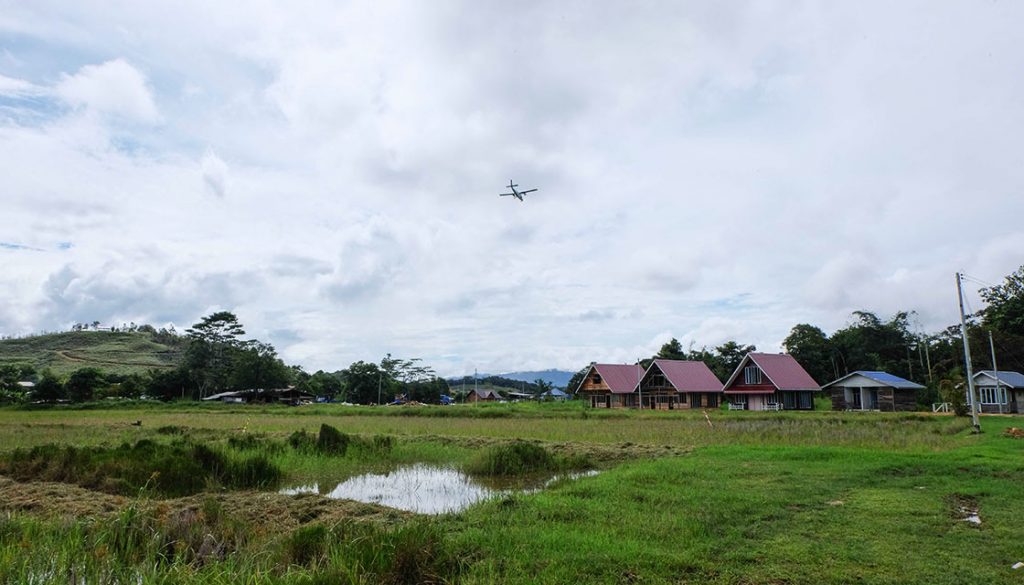It has always been a dream of anyone to take a break from the urban sprawl and visit the relaxed countryside. A place where the air is cleaner, the views are extraordinary and the life is simple. Here in Malaysia, there are tons of places that will give you that kind of desire and one of those is Bario Highlands.
Bario Highlands – a gathering of wooden cabins and quaking rice paddies. It is a place which has been endowed with multitudes of historical, cultural and fascinating tourist attractions. Last May, I got the chance to explore the enchanting Bario and discover its amazing wonders. Join me, together with my trail running buddy as we unleashed the beauty that is Bario.
Bario beginnings

Lying at an altitude of about 3,500 feet above sea level in the north eastern corner of Sarawak and a gateway in the beautiful mountain valley of Kelabit Highlands is the famous Bario. Known as the “land of a hundred handshakes” for its friendly locals, Bario is a portmanteau of Ba-a and Marariu meaning “windy swamp” in the Kelabit language.
The Kelabits were originally a tribe of fierce warriors and headhunters who spoke their own local language. During the World War II, British troops made a parachute drop into Bario and set up the town as their Headquarters. After the war ended, the British troops eventually left the place and were replaced by the arrival of Christian missionaries. As being influenced by their religion, until today, the Kelabit people are predominantly Christian.

With a population of approximately 5,000 people, the Kelabit is one of the smallest ethnic groups in Sarawak. Like many other indigenous communities in Sarawak, the Kelabit live in longhouses in the highlands. The Kelabit language is widely spoken, while many have also learned to speak English and Bahasa Malaysia.

Engaging
My journey began as we took a 2-hour and 15-minute flight from Kuala Lumpur to Miri. Then from Miri to Bario Highlands, in a 16-seater turboprop plane. For those who has never flown in a small plane, this is definitely an exceptional experience. You can see the amazing aerial view of the mountain peaks like a cloth draped over a pillow. The takeoffs and landings are the ones to look out for while on board, it is only you, the local villagers, pilot and co-pilot in the plane. Note to those who want to go to Bario, there are only three flights daily from Miri to Bario. If you’re planning to pay a visit to this magnificent highlands, book your flight early.

Upon arrival to Bario, I was in great awe with the untouched natural beauty of the place as well as its isolation characteristics making Bario mysteriously interesting. It is like an upland bowl surrounded by rocky cliffs and serrated limestone peaks.

We stayed in one of their famous longhouses that was built during the 1950s. As cultures adapt throughout time, the longhouse will remain culturally sustainable, a constant home. The longhouse family’s clan symbol was hung over at the long and very cosy hallway of the longhouse. By looking through those black and white photos I feel like I’m walking down to their memory lane. Those remnants of the past is indeed a treasure that’s worth keeping.

What to do in Bario?
As soon as I reached Bario, the weather is relatively bad. The dark clouds loomed over the tree tops and it started to drizzle. That certainly won’t stop me from exploring the fascinating Bario. I decided to first visit a small hill with a large amount of pineapple being planted in the area. The Hill has an overlooking view on the Bario farmlands.

Bario pineapple is juicy, sweet and totally organic. Apart from the tasty pineapple, Fragrant Bario rice also has a sweet and premium taste. You can only find Bario rice in East Malaysia however. It’s very hard for you to find it elsewhere. I guess the high altitude of this place is the reason for the pineapple and rice to have a distinct taste.

Every mountain in Bario has a story. From the Bario Asal Longhouse, it’s a steep, slippery ascent (two hours) up to the summit of Prayer Mountain, which has a wooden cross that was erected in 1973. Brushes of pitcher plants and the 360 views of the Bario Valley can be seen at the peak.

Next stop, is the crash site. My tour won’t be complete without even paying a visit to this place, where the history and discovery of Bario Highlands took place. As I went through this site, the light rain escalated into a heavy downpour that forced me to return to the longhouse.

When you visit Bario, you are most likely be introduced to a traditional Kelabit dance performance at one of the local longhouses. And I was not an exception for that, during my stay. A senior residing in the longhouse celebrated his birthday so they invited the residents and guests to dance, party and eat a full traditional Kelabit dinner.


Bario has their own Food Festival called ‘Pesta Nukenen’. It is a 3-day festival during the month of July when you can be assured of some pretty unique local dishes, traditional and cultural performances. Through this celebration, you can see the entire highland community getting together for this festival.
Feel the Bario Trail
If you happen to visit Bario in May, join the Runners Wild Bario, a trail running event. The run will lead you to the rain forest packaged with sounds from squealing birds and monkeys hoot. You could even see wild animals crossing the trail as you run and explore the undisturbed nature of Bario.


Don’t forget to bring these items with you to the trail:
- Headlamp
- 2 Litre water bladder or water storage
- Light snacks/food for fuel up
- Rain jacket
- Emergency blanket
- Whistle
Cellular coverage in Bario Highlands is weak. But, bringing your mobile phone along with you could be helpful at times of need. If not, use it to take some nice pictures of the trail and bring home with you.



The Runners Wild Bario trail run was initiated as a platform for the Bario community to create a new tourist attraction in the scenic Kelabit Highlands.


If you want to go somewhere remote then Bario is the right place for you. With its unique tribes, Bario indeed showcases an amazing lifestyle and strong culture. Will I come back to this highlands again? Yes, I definitely will.







